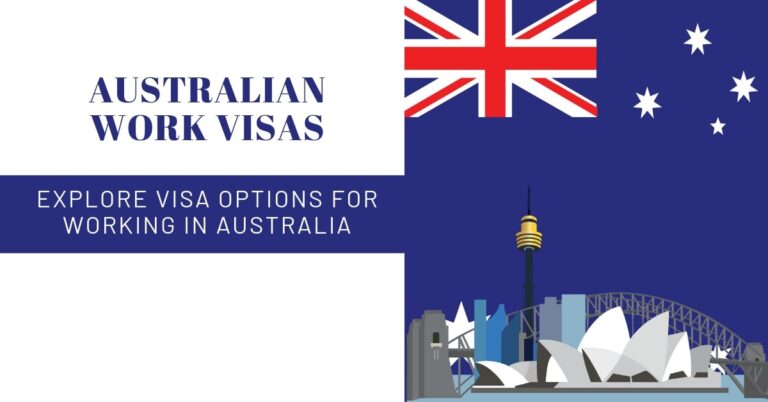AUSTRALIA WORK VISA: Essential Guide for Aspiring Applicants
Navigating the process of securing an Australia work visa can seem complex, but it doesn’t have to be.
To work in Australia, you need a visa that matches the job you plan to do. Depending on your qualifications and the nature of your work, you can choose from several options.
If you’re looking for a more permanent opportunity, consider permanent work visas designed for skilled migrants, entrepreneurs, and investors. These visas offer the chance to settle in Australia long-term with pathways to citizenship.
For short-term employment, there are temporary work visas that allow you to work in Australia on a provisional basis.
Each visa type has its own eligibility criteria, so it’s crucial to understand what fits best for your situation.
Types of Australia Work Visas
Australia offers various work visas tailored to different needs and qualifications. The main types include the Temporary Skill Shortage Visa (Subclass 482), the Skilled Independent Visa (Subclass 189), and the Employer Nomination Scheme (Subclass 186).
Temporary Skill Shortage Visa (Subclass 482)
The Temporary Skill Shortage Visa (Subclass 482) allows employers to address labor shortages by bringing in skilled workers from overseas.
This visa has short-term and medium-term streams.
You need job sponsorship from an approved employer and must have relevant skills for the position.
This visa lets you stay in Australia for up to four years, depending on the stream. Additionally, it provides a pathway to permanent residency.
Skilled Independent Visa (Subclass 189)
The Skilled Independent Visa (Subclass 189) is for skilled workers not sponsored by an employer, a state, or a territory.
This visa is points-tested, meaning you need to score enough points in the system based on factors like age, work experience, and English language proficiency.
No job offer is required. You can live and work anywhere in Australia permanently. Moreover, you and your family members can access healthcare and other social benefits.
Employer Nomination Scheme (Subclass 186)
The Employer Nomination Scheme (Subclass 186) enables Australian employers to sponsor skilled workers for permanent residency.
There are three streams within this visa: Direct Entry, Temporary Residence Transition, and Labour Agreement.
Each stream has specific requirements. Generally, you need a job offer in your nominated occupation and must meet the skill and English language criteria.
This visa offers a pathway to permanent residency, allowing you to live and work in Australia indefinitely.
Eligibility Criteria
To qualify for an Australian work visa, you must meet certain requirements, including undergoing a skills assessment, having your occupation listed on specific government-approved lists, and demonstrating proficiency in English.
Skills Assessment
Before applying for a work visa, you need to pass a skills assessment.
This assessment verifies that your skills and qualifications match Australian standards for your specific occupation.
Assessing authorities like the Australian Computer Society and Engineers Australia conduct these evaluations.
Each authority has its own criteria and can include professional experience, education, and sometimes practical tests.
Ensure you gather all necessary documents, such as diplomas, certificates, and references, before submitting your application to the assessing authority.
Occupation Lists
Your occupation must be on one of Australia’s occupation lists to be eligible for a work visa.
Two main lists are the Medium and Long-term Strategic Skills List (MLTSSL) and the Short-term Skilled Occupation List (STSOL).
These lists are updated regularly to meet the changing needs of the Australian labor market. Being on the list indicates that your skills are in demand in Australia.
You can check current listings on the Department of Home Affairs website.
English Language Requirements
Proficiency in English is essential for obtaining a work visa.
You need to pass an approved English language test, such as the IELTS, TOEFL, or PTE.
Generally, a higher band score increases your points, which is critical in the point-based immigration system Australia uses.
Specific visa subclasses might have different score requirements.
For example, to gain maximum points, you must score 8 bands or higher in the IELTS.
Keep your test results recent, as outdated scores may be invalid for your application.
Application Process
To start working in Australia, you need to understand several main steps. These steps include showing your interest, submitting your visa application, and providing supporting documents.
Expression of Interest
First, you must submit an Expression of Interest (EOI). This indicates your intent to apply for a work visa.
You do this through the SkillSelect online system.
Fill in details about your skills, work experience, and qualifications. This information helps assess your eligibility.
You may receive an invitation to apply for a visa if you meet the criteria and there are open spots.
Responses to EOIs are prioritized based on the score you achieve on the points test.
You must score at least 65 points to be considered. Skills in high demand may lead to faster processing and invitation.
Visa Application Submission
Once you receive an invitation, you can submit your visa application.
This step involves filling out detailed forms and providing accurate information.
Be thorough and honest, as false information can lead to visa rejection.
Pay the required visa application fees. Ensure all fees are paid on time.
Submit your application through the official Department of Home Affairs website.
After submission, you will receive a confirmation and a tracking number.
Supporting Documents
You must provide several supporting documents along with your visa application.
These documents include proof of identity, such as a valid passport. You also need documents verifying your education, work experience, and skills assessment results.
Other necessary documents include police clearance certificates and health examinations.
If you are bringing family members, include their relevant documents as well.
Carefully check all requirements to make sure you include everything needed. Missing or incorrect documents can delay the processing of your visa.
For more detailed information, visit the Department of Home Affairs.
Visa Fees and Processing Time
When applying for a work visa in Australia, it’s crucial to understand the costs and how long the process might take.
Fees
Visa fees depend on the type of visa and what you plan to do in Australia. For example:
- Visit: Tourist visa fees.
- Study: Fees for student visas.
- Work: Work visa fees vary based on the specific visa.
- Live: Permanent residency visa fees.
You can check the Visa Pricing Table for updated fees for each category.
Processing Time
Processing times for visas can vary with different factors:
- Type of Visa: Different visas have different processing durations.
- Volume of Applications: Busy periods can extend wait times.
- Completeness of Application: Applications with all required documents process faster. Use the checklists available at ImmiAccount to ensure you submit everything needed.
Here are some examples of processing times:
- Permanent Visas: Around 6 to 18 months according to Visa Processing Times.
- Work Visas: Times vary based on the visa type and the case’s complexity.
Applying online is recommended as it helps streamline processing and reduce delays. More details about processing times can be found on the Global Visa Processing Times page.
Working in Australia
When working in Australia, it’s crucial to know your rights and understand the workplace culture. These aspects ensure you have a positive and productive experience.
Employee Rights and Duties
In Australia, all workers have basic rights regardless of their visa status. These rights include fair pay, safe working conditions, and protection from unfair treatment.
The Fair Work Ombudsman enforces these rights.
Employers cannot cancel your visa, even if you breach your visa conditions. Contracts or agreements cannot take away these rights.
You are also entitled to paid leave, such as annual leave and sick leave.
If you feel your rights are violated, you can contact the Fair Work Ombudsman for help.
Australian Workplace Culture
Understanding the workplace culture is essential for smooth integration.
Australian workplaces value punctuality, open communication, and teamwork. Being on time for work and meetings is highly regarded.
Australians are known for their direct communication style. It’s common to receive straightforward feedback.
Teamwork is fundamental in Australian workplaces.
You are expected to collaborate with colleagues and contribute your ideas. Socializing with coworkers is also common, whether it be during breaks or after-work activities. This helps build strong working relationships.
Sponsorship and Nomination
When applying for an Australian work visa, two key processes are sponsorship and nomination. Employers must become approved sponsors and understand their obligations to successfully nominate a skilled worker.
Becoming a Sponsor
To sponsor an employee, your business must first gain approval as a sponsor by the Department of Home Affairs.
This involves applying for Standard Business Sponsorship. You will need to show that your business is legally operating and demonstrate a commitment to training local employees.
Once approved, you can nominate employees for specific roles.
Different visa types, such as the Employer Nomination Scheme (subclass 186) visa, have specific requirements, including necessary skills assessments and possibly, a labor agreement.
Obligations of Sponsors
As an employer, sponsoring a worker comes with certain obligations.
You must ensure that the position is genuine and that the salary meets the market rate. It is also required to cover the costs associated with the nomination and any migration agent fees.
You are also responsible for the sponsored worker’s welfare, including compliance with Australian workplace laws.
This includes ensuring that the employee’s work responsibilities align with their visa conditions and that they maintain the required work performance and conditions throughout their employment period.
Strict adherence to these obligations is essential to maintaining your status as an approved sponsor and preventing any legal issues.
Family and Partner Visas
When moving to Australia on a work visa, you might want to bring your family with you. It’s possible to include your spouse or de facto partner in your visa application.
If you’re already in Australia, your partner can join you by applying later. They will need to pass health and character checks to be accepted.
Partner Visa Options
There are several types of partner visas:
- Temporary Partner Visa (Subclass 820/309): For those married or in a de facto relationship.
- Permanent Partner Visa (Subclass 801/100): After holding a temporary visa, you can apply for this.
More details can be found here.
Application Steps
- Gather Documents: Proof of relationship, identity documents, etc.
- Submit Application: You can do this online through your ImmiAccount.
- Wait for Approval: Processing times vary; you can request priority processing if needed.
Bringing Children
To bring your children to Australia, they will need a visa. If they are born overseas, you can apply for Australian citizenship by descent for them. Once approved, they can get an Australian passport. Learn more about this here.
Including your family in your work visa application can make your move to Australia much smoother.
Health and Character Requirements
To obtain an Australian work visa, you must meet certain health and character requirements. These standards ensure that newcomers do not pose health or safety risks to the community.
Health Requirements
Australia maintains high health standards. You must undergo a medical examination by a panel doctor to meet these standards.
- Common assessments include:
- Physical examination
- Chest X-ray
- Blood tests
You can find more details on the specific tests and criteria at the Immigration and citizenship website.
Character Requirements
The character requirements are set out under section 501 of the Migration Act 1958. You must pass these to get your visa.
- Typical requirements include:
- Police certificate
- Military certificate
- Statutory declaration
- Letter of good conduct
These documents help assess your character and can be requested after you submit your application. More information can be found on the VisaGuide.World.
Ensuring you meet these health and character standards is vital for your visa application process.
Bridging Visas
Bridging visas in Australia allow you to stay lawfully while your immigration status is being resolved. These visas provide temporary relief and certain rights.
There are several types of bridging visas, each with its own conditions.
The most common are Bridging Visa A (BVA), Bridging Visa B (BVB), and Bridging Visa C (BVC).
- Bridging Visa A (BVA) is for people who already hold a valid visa and need another while waiting for their primary visa application to be processed. You can stay legally in Australia but cannot travel overseas.
- Bridging Visa B (BVB) allows you to leave and re-enter Australia while your new visa application is processed. This is useful if you need to travel temporarily during the waiting period.
- Bridging Visa C (BVC) is for those who do not hold a valid visa but have applied for a substantive visa. This visa lets you stay in Australia but does not allow you to work unless you meet certain criteria.
Work Rights on Bridging Visas:
- BVA generally carries the same work rights as the visa you held at the time of application.
- BVB also maintains the same work rights.
- BVC typically does not include work rights, but you can request permission to work if you can prove financial hardship.
For specific details on applying for these visas, you can visit the Home Affairs website.
These bridging visas are essential if you’re waiting for a decision on a substantive visa application. They provide you with certain rights and ensure you remain lawful during the waiting period.
Permanent Residency Pathways
There are several pathways to gaining permanent residency in Australia. Each pathway has its own criteria and benefits.
Family-stream permanent visas are for those who have family members living in Australia. You may qualify through a partner, child, or other eligible relative.
Work-stream permanent visas are based on skills and employment. These are ideal if you have specific skills in demand in Australia. You can apply through employer nomination or independent skills programs.
Business or investor-stream permanent visas cater to people willing to invest or start a business in Australia. This option requires significant financial investment.
To find out if you meet the criteria and to explore the options available, visit the Visa options for permanent residents.
Regional work visas are designed for skilled workers who choose to live and work in regional Australia.
Programs like the Regional Sponsor Migration Scheme offer opportunities to work in areas with labor shortages.
If you study in Australia, certain courses can lead to permanent residency. The investment can provide long-term benefits and stability after graduation. For more details, see the list of PR Courses.
Regional Migration
Australia offers several visas for skilled migrants looking to live and work in regional areas.
You can apply for a Skilled Work Regional (Provisional) visa (subclass 491) if you are nominated by a State or Territory government or sponsored by an eligible relative. This visa allows you to stay in regional Australia for up to five years.
To be eligible, you need to:
- Be under 45 years of age
- Have a relevant skills assessment
- Score at least 65 points on the migration points test
Another option is the Skilled Employer Sponsored Regional (Provisional) visa (subclass 494). You need an employer sponsor based in regional Australia for this visa. This visa also lasts up to five years and provides a pathway to permanent residency.
Benefits of Regional Migration:
- Extra points on the Skilled Migration Points Test
- Greater chances of obtaining a visa due to high demand
- Access to specific regional incentives
Designated regional areas are split into two categories:
- Cities and Major Regional Centres
- Regional Centres and Other Regional Areas
Migrating to these areas can boost your chances of obtaining permanent residency. More information on regions can be found here.
Check the specific requirements and make sure you meet all the criteria before applying. For further guidance, consult the Home Affairs website.




